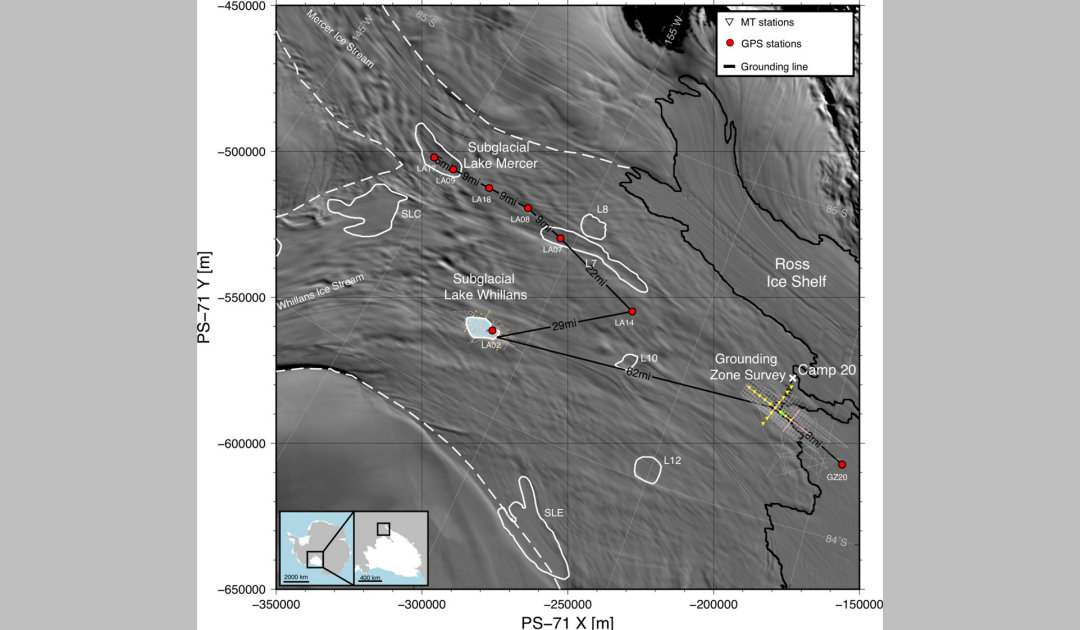
Water is ubiquitous in Antarctica, mostly as ice and snow. Only where melt ponds or lakes and meltwater streams are formed, liquid fresh water is found. An exception are the outlets that lie beneath the countless glaciers and ensure that the ice masses above are constantly in flow. U.S. researchers have now discovered that water masses also lie deep in the ground of the Antarctic subsurface, forming a previously undiscovered and unexplored water reservoir.
A research team including lead author Chloe Gustafson and Professor Kerry Key of Columbia University, Matthew Siegfried of the Colorado School of Mines, and mountaineer Meghan Seifert discovered volumes of water in the sediments beneath the Whillans Ice Stream at the edge of West Antarctica and the Ross Ice Shelf that could contain volumes up to ten times greater than the overlying subglacial network beneath the ice. This groundwater network, whose existence has long been talked about but never proven, is also in direct exchange with the runoff water of glaciers and ice streams and therefore forms a hitherto unknown aspect of the flow dynamics of Antarctic ice sheets. Chloe Gustafson and her colleagues have published these and other findings in the latest issue of the journal Science.

The results of the work paint an expanded picture of Antarctic hydrology. For until now, it was assumed that water masses flow from the surface of the ice masses into the depths, there afterwards collect and rest on the bedrock, forming a network of lakes and rivers lying on a layer of sediment. “People had speculated that there might be a deep groundwater system in the sediments,” says Chloe Gustafson, who conducted the study as part of her doctoral research. “But until now, no one had created a detailed picture of this.” With the results, the team shows that entire sedimentary basins with huge amounts of water exist beneath the known subglacial water systems and form real reservoirs. These water masses, the researchers hypothesize, could be in exchange with runoff water masses through the sediment layers.



The work was conducted on the Whillans Ice Stream because previous studies of a possible subglacial water network there had discovered, among other things, a lake with a thick sediment layer on the bottom. Microbes had been discovered in this layer, showing that life could also be possible under the ice of Antarctica. Gustafson and the team wanted to investigate this layer further, using magnetotelluric imaging techniques. To do this, they placed measuring instruments in snow pits on the surface of the ice stream and measured the natural electromagnetic emissions of the different parts under the ice stream. This allowed them to obtain an accurate MRI-like image and thus found that the sediment layers were up to two kilometers deep and had only been mixed with fresh water at the upper parts. The deeper the layer was, the more salt water the researchers found in the layers. This water represents a type of paleo-water layer because it likely came from a time when the sedimentary basins were part of the seafloor and no ice had covered them, about 5,000-7,000 years ago, according to Professor Kerry Key, a geophysicist at Columbia University.
The results of the study are remarkable not only in that they show a previously unknown water reservoir of huge proportions. This is because the water masses are also likely to be an important component in the flow dynamics of Antarctica’s glaciers. According to the study team, the fact that runoff water flows into the sediment layers under the glacier and remains there could act as a kind of brake and help regulate the flow rate of ice flow. This is also where the researchers see the greatest danger in the event of a possible melting of the glacier. This is because the decreasing weight reduces the pressure on the sediment layer and thus the groundwater could reach the top and increase the flow velocity of the system. Furthermore, since the water masses in the sedimentary layers reach down to the bedrock, geothermal energy would reach the surface and further melt the ice masses from below. But if at all, how strong and how fast is not clear. First, more data must be collected on the extent of these unknown water masses elsewhere. But the work shows once again that there are still many secrets waiting to be discovered under the ice of Antarctica.
Dr. MIchael Wenger, PolarJournal
More about this topic:





